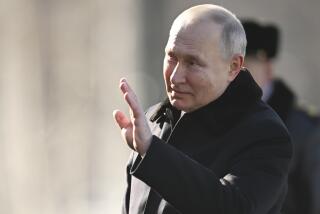THE REYKJAVIK SUMMIT: THE AFTERMATH : REYKJAVIK: ACCORD AND DISCORD
- Share via
Basic provisions of the arms control measures discussed by President Reagan and Soviet leader Mikhail S. Gorbachev in Iceland, and the tentative agreements they reached:
MISSILE DEFENSES:
Soviet position: Amend the existing Anti-Ballistic Missile Treaty to specify that only laboratory research is permitted on ABM systems. Require both sides to promise to adhere to the treaty for 10 years instead of the current six months. Before the summit, Moscow had proposed a 15-year extension of the treaty.
U.S. position: Keep the existing ABM treaty for 10 years, with the explicit understanding that the treaty allows not only research but also development and testing (but not deployment) of Reagan’s space-based defensive system, known as the Strategic Defense Initiative, or “Star Wars.” Before the summit, the United States had proposed binding each side to the treaty for five years.
LONG-RANGE NUCLEAR WEAPONS:
Tentative agreement: Impose a ceiling on each side of 6,000 warheads on 1,600 delivery vehicles--approximately a 50% reduction in each side’s arsenal. Before the summit, the Soviets had proposed a ceiling of 8,000 warheads and the United States had proposed 7,500, with no more than 5,500 of them on ballistic missiles and no more than 3,300 of them on ground-launched vehicles, the mainstay of the Soviet arsenal.
Soviet position: The reduction would be contingent on U.S. acceptance of the Soviet position on missile defenses.
U.S. position: The United States rejected linking long-range weapons to missile defenses and offered instead to require both sides to reduce their arsenals by 50% in five years and their ballistic missiles to zero in another five years. Both sides could retain bombers and cruise missiles.
MEDIUM-RANGE NUCLEAR MISSILES:
Tentative agreement: Elimination of all warheads in Europe, with the Soviets allowed to keep 100 warheads in Asia and the United States 100 warheads in reserve at home. Today’s Soviet arsenal in Europe stands at 819 warheads and the U.S. force at 236. The Soviets now have 513 warheads in Asia. Before the summit, both sides had proposed ceilings of 100 missiles in Europe. In Asia, the Soviets had proposed a freeze at their current level, and the United States had asked for a “proportionate” reduction.
Soviet position: The new ceilings would be contingent on U.S. acceptance of the Soviet position on missile defenses, a reversal of a previous promise to keep the two issues separate.
U.S. position: The United States rejected the linkage.
NUCLEAR TESTING:
Tentative agreement: The United States would submit two decade-old limited test bans to Congress for approval, and the superpowers would begin negotiations on “improved verification procedures.” After adequate measures were agreed upon, new negotiations would begin to further limit nuclear tests with the ultimate goal of a total test ban in parallel with reductions toward zero of offensive nuclear weapons. Before the summit, the Soviets had demanded an indefinite testing moratorium, but they dropped it at Iceland.
Soviet position: The Soviets, contrary to their previous position, tied their offer to the dispute over missile defenses.
U.S. position: The United States rejected the linkage.
More to Read
Sign up for Essential California
The most important California stories and recommendations in your inbox every morning.
You may occasionally receive promotional content from the Los Angeles Times.













